|
Winemaking
at Hilltop Farm
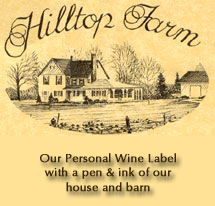
Merrily and I are often asked why we became interested in making wine.
Other than temporary insanity we have no logical explanation. However,
this strange hobby has persisted for many years and has contributed to
our zest for living.
Each year we dream that this year we will make that world-renowned wine.
To date, this has not happened but our dream persists.
The Chemistry of Wine
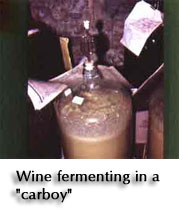 Having
received a major in chemistry in undergraduate school has contributed
to my interest and challenge. I thought that careful chemical analyses
and learning all I could by reading and attending courses on winemaking
might contribute to the fulfillment of that dream. While we have had some
successes in national competition*, still that great wine remains a dream.
Perhaps next year? Having
received a major in chemistry in undergraduate school has contributed
to my interest and challenge. I thought that careful chemical analyses
and learning all I could by reading and attending courses on winemaking
might contribute to the fulfillment of that dream. While we have had some
successes in national competition*, still that great wine remains a dream.
Perhaps next year?
The carrying out of our dream started with spending a morning with Dr.
Einset who was in charge of grape and wine research at Cornell Experiment
Farm at Geneva NY. He was very helpful with his advice on viticulture
and varieties of grapes that are cold hearty enough to withstand our cold
winters.
Getting Started
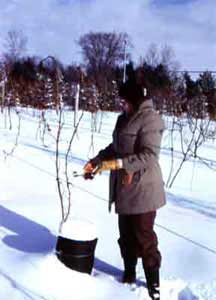 We
found that putting up trellises and planting the grapes were more work
that we anticipated. However with the help of our son and daughter-in-law,
this was accomplished. Here is a picture of the early stage of our vineyard.
After the first year, the vines have to be pruned. Winter time is the
ideal time (for the heath of the vines) to prune the vines but often proves
to be a difficult task because of our cold winters. We
found that putting up trellises and planting the grapes were more work
that we anticipated. However with the help of our son and daughter-in-law,
this was accomplished. Here is a picture of the early stage of our vineyard.
After the first year, the vines have to be pruned. Winter time is the
ideal time (for the heath of the vines) to prune the vines but often proves
to be a difficult task because of our cold winters.
Here is a picture of Merrily working on a cold day
as you can see from the thermometer.
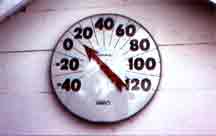 Gloves
and hand warmers were a big help. It is only fair to admit that our enthusiasm
for pruning in the cold has lessened as the years have gone by. Gloves
and hand warmers were a big help. It is only fair to admit that our enthusiasm
for pruning in the cold has lessened as the years have gone by.
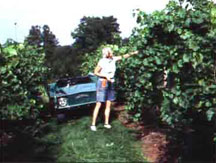 Progress Progress
This picture was taken several years later. Note how the how the vines
have grown. Here Merrily is picking grapes for our September harvest and
proudly displays the result of our labors.
The Process
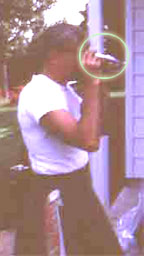 In the
fall we wait for the grapes to build enough sugar to make a proper wine.
In this area we shoot for a sugar content of 18 to 22%. Here our son Tom
is checking the sugar content of the juice with a refractometer. The refractometer
is a big help as it requires only a drop of juice to get an accurate reading
of the sugar content. In the
fall we wait for the grapes to build enough sugar to make a proper wine.
In this area we shoot for a sugar content of 18 to 22%. Here our son Tom
is checking the sugar content of the juice with a refractometer. The refractometer
is a big help as it requires only a drop of juice to get an accurate reading
of the sugar content.
First the grapes are put through a stemmer-crusher as shown here. As
the name indicates, this crushes the grapes and removes the stems. From
there the crushed fruit goes into a press where the juice is squeezed
out.The juice is then placed in carboys (usually five and seven gallons
distillata bottles), yeast is added (about one gram per five gallon of
juice) to the juice and fermentation hopefully follows in a few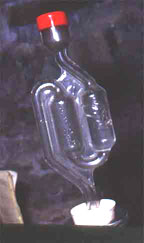 days.
As seen in the picture, a water seal is placed on the top of the carboy
which allows carbon dioxide to escape without allowing oxygen to enter
the carboy. The water seal is partially filled with water. Once wine is
fermented, it should be protected from oxygen as much as possible. days.
As seen in the picture, a water seal is placed on the top of the carboy
which allows carbon dioxide to escape without allowing oxygen to enter
the carboy. The water seal is partially filled with water. Once wine is
fermented, it should be protected from oxygen as much as possible.
When wine has stopped fermenting and the dregs settle our to the bottom
of the carboy, it is racked (siphoned off) into a clean carboy making
an attempt separate the clear wine form the sediment in the bottom of
the jug. This is repeated several times.
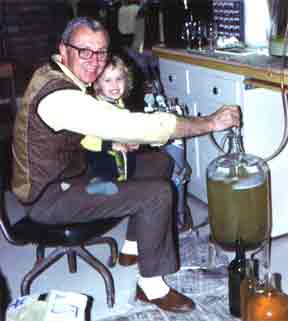 Here
one of our granddaughters, Beamie, assisting me. Here
one of our granddaughters, Beamie, assisting me.
After the Harvest
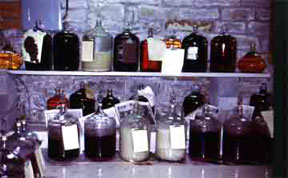 In this
picture, we see the wines that has been placed in carboys. At this stage
various tests are carried. It is at this time that we can add various
chemicals or remove some of the undesirable tastes in the wine. To me,
this is the most interesting and challenging phase of winemaking. At times
it allows the winemaker to use his knowledge to make an undrinkable wine
into a drinkable wine. At other times, it permits the winemaker the chance
to convert a mediocre wine to a very pleasant wine. In this
picture, we see the wines that has been placed in carboys. At this stage
various tests are carried. It is at this time that we can add various
chemicals or remove some of the undesirable tastes in the wine. To me,
this is the most interesting and challenging phase of winemaking. At times
it allows the winemaker to use his knowledge to make an undrinkable wine
into a drinkable wine. At other times, it permits the winemaker the chance
to convert a mediocre wine to a very pleasant wine.

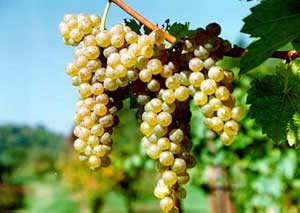
|